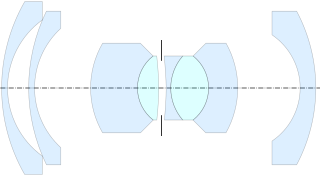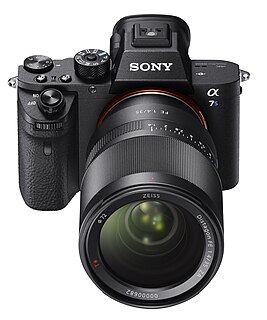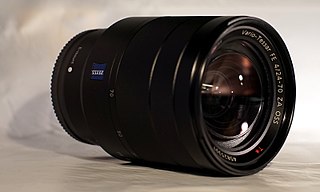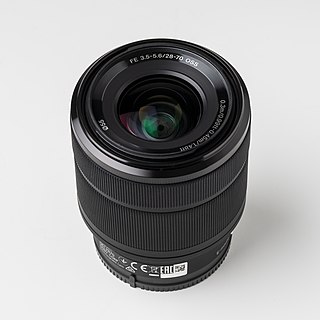This article needs additional citations for verification .(January 2018) (Learn how and when to remove this template message) |
| Maker | Zeiss |
|---|---|
| Lens mount(s) | Sony E-mount |
| Technical data | |
| Type | Prime |
| Focal length | 21mm |
| Image format | 35mm full-frame |
| Close focus distance | 0.25 metres (0.82 ft) |
| Max. magnification | 0.13x |
| Diaphragm blades | 10 |
| Construction | 11 elements in 9 groups |
| Features | |
| Manual focus override | |
| Weather-sealing | |
| Lens-based stabilization | |
| Aperture ring | |
| Unique features | Digital focus distance scale |
| Application | Landscape, Architectural |
| Physical | |
| Max. length | 72 millimetres (2.8 in) |
| Diameter | 62 millimetres (2.4 in) |
| Weight | 394 grams (0.869 lb) |
| Filter diameter | 52mm |
| Accessories | |
| Lens hood | Barrel-type, metal |
| History | |
| Introduction | 2015 |
| Retail info | |
| MSRP | $1499 USD |
The Zeiss Loxia Distagon T* 2/21mm is a full-frame (FE) wide-angle manual focus prime lens for the Sony E-mount, announced by Zeiss on October 12, 2015.

In photography and cinematography, a wide-angle lens refers to a lens whose focal length is substantially smaller than the focal length of a normal lens for a given film plane. This type of lens allows more of the scene to be included in the photograph, which is useful in architectural, interior and landscape photography where the photographer may not be able to move farther from the scene to photograph it.
In the field of photography, a manual focus camera is one in which the user has to adjust the focus of the lens by hand. Before the advent of autofocus, all cameras had manually adjusted focusing; thus, the term is a retronym.
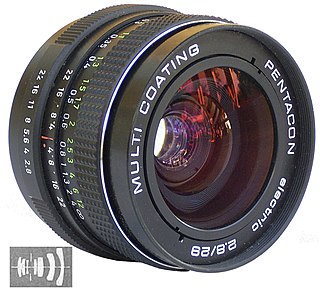
In film and photography, a prime lens is a fixed focal length photographic lens, typically with a maximum aperture from f2.8 to f1.2. The term can also mean the primary lens in a combination lens system. Confusion between these two meanings can occur if context doesn't make the interpretation clear. People sometimes use alternate terms—primary focal length, fixed focal length, or FFL to avoid ambiguity.
Contents
Though designed for Sony's full frame E-mount cameras, the lens can be used on Sony's APS-C E-mount camera bodies, with an equivalent full-frame field-of-view of 31.5mm.
In cinematography, full frame refers to the use of the full film gate at maximum width and height for 35 mm film cameras. It is sometimes also referred to as silent aperture, full gate, or a number of other similar word combinations. It is the original gate size pioneered by William Dickson and Thomas Edison in 1892 and first used in the short film Blacksmithing Scene. Full frame is generally used by all 4-perf films, whether silent, standard 35, or Super 35. The introduction of Academy ratio in 1932 required that the lens mount needed to be shifted slightly horizontally to re-center the lens at the new center of frame; however, the gate size did not change as the extra negative information would be cropped out by lab processes in post-production. 4-perf Super 35 is nearly identical to the original full frame standard, although the lens mount requires vertical re-centering when common topline extraction is used. Hard mattes for all common ratios exist and either replace the film gate itself or are inserted within it. However, these are usually not used in the event that any reframing needs to be done.

Advanced Photo System type-C (APS-C) is an image sensor format approximately equivalent in size to the Advanced Photo System film negative in its C ("Classic") format, of 25.1×16.7 mm, an aspect ratio of 3:2.






